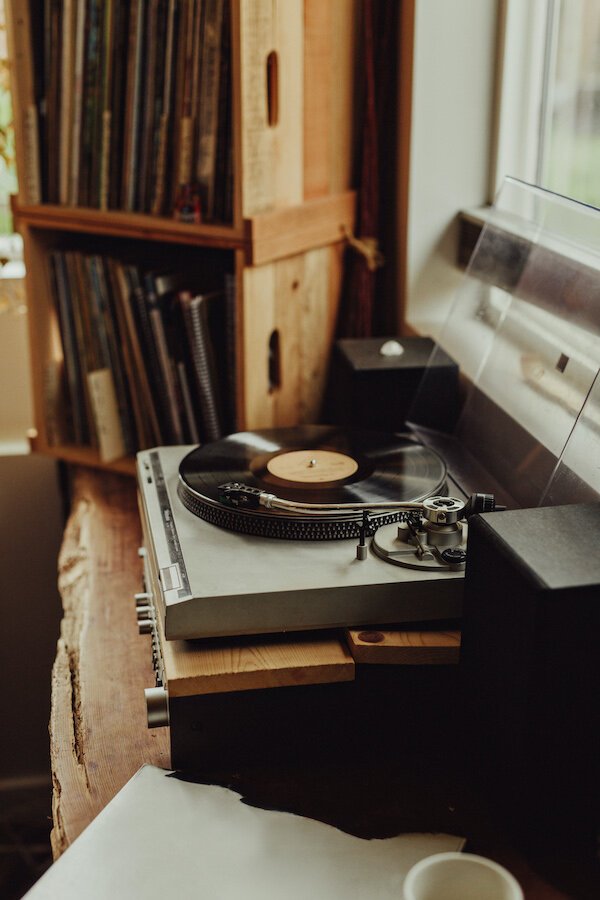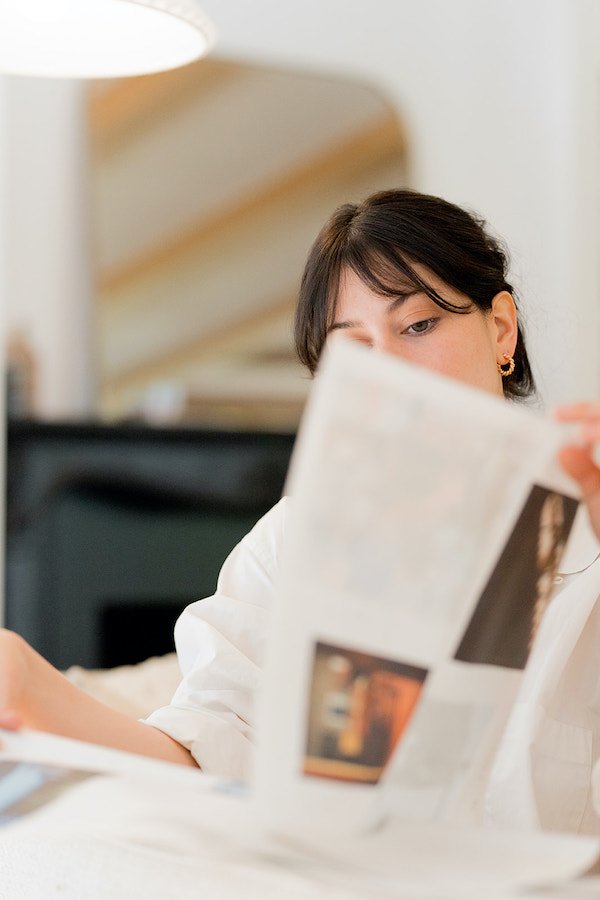
Your Guide To Finding A Vintage Record Player
🎶 Put Your Records On 🎶
The first record I ever bought was a pristine version of the Rolling Stones’ Made in the Shade, for all of two dollars. Since then, I’ve been gifted Adele and Leon Bridges vinyls and collected my own sets from Miles Davis and John Coltrane. And when that turntable stylus touches down and the record slowly crackles, there’s nothing quite like it. I love how inviting and nostalgic it is—physical media connects with me in a way that most digital art can’t.
“There’s something so inviting and nostalgic about playing a record.”
It seems I’m not alone in preferring records over streaming. In 2019, vinyls were poised to outsell CDs (remember those?) for the first time since 1986. And sales increased almost 30 percent in 2020, raking in a massive $620,000,000. Yes, you read that correctly.
If you, too, are hoping to get your hands on some old-school vinyl and a vintage record player, you’re in the right place.
Are Vinyl Records Sustainable?
But first, there’s no sugarcoating it: The materials and production of vinyl aren’t exactly sustainable.
Back when vinyl was the only real source for in-home entertainment, being green wasn’t necessarily top of mind; after all, Edison invented the first-ever record back in the 1880s. But today, when you can open Spotify to instantly source music to match your mood, weather, or even intimacy level, it’s worth considering the long-term ethics.
Most records are made with PVC (aka plastic), which we already know takes hundreds of years to decompose. The production process is hard on the environment too, typically requiring fossil fuels, anti-corrosive chemicals to prevent rusting, and plastic-based packaging.
“The good news is that vinyl records are rarely thrown away in comparison to other plastic goods.”
The good news is that vinyl records are rarely thrown away in comparison to other plastic goods. They’re often purchased and kept over decades to build collections, upcycled into art pieces, or donated to charities and secondhand shops. To some extent, high-quality records can be recycled into other albums.
And if you’re thinking that digital streaming is the only green way to go, consider this as well: The amount of energy needed to store, retrieve, and play billions of digital songs throughout one day is already tolling on our environmental footprint. In contrast, once a vinyl has been produced, the ongoing impact is minimal.
But the times, they are a-changin’ when it comes to sustainable records. In recent years, environmentalists, musicians, and record companies alike are re-imagining both the process and the products. Green Vinyl Records, consisting of eight different Dutch companies, has been perfecting an eco-friendly production process that reduces energy use and waste by 60 percent. Separately, businesses are exploring HD vinyl cut by laser (versus lacquer) and innovative 3D printing.
“The times, they are a-changin’, when it comes to sustainable records.”
Time will tell if these new methods will yield quality results, but even then, studios and musicians are thinking creatively. Some are releasing their work in small limited-edition batches using renewable energy and materials, while others are turning to local production and distribution in order to reduce emissions.
All of this to say: No one way of listening to music—records, cassettes, CDs, or streams—is perfect. But consumers have influence over sustainability in the music industry, and we’re anxiously waiting to see what’s next.
How To Find A Vintage Record Player
While you can definitely find more modern record players through big-box stores, vintage is always a good option (just like with fashion!). Though if you have to buy new, consider record players that use more sustainable materials like bamboo and recycled aluminum, like this one.
Before you start actively searching, set aside a budget you can stick to. Depending on the age, quality, and materials, vintage record players are sometimes upwards of $300, though we’ve come across steals in the $100-200 range. The best vintage players will be crafted with aluminum or steel, while the lesser ones will be made of—you guessed it—plastic. Why is aluminum better? According to major record player retailer Victrola, aluminum provides more balance to keep vibrations to a minimum, whereas cheaper materials have lower inertia and are more prone to instability.
“Plan to collect all kinds of records? Prioritize a player that offers varying speeds and understand if it’s a manual switch or an automatic one.”
Then, you’ll want to make sure a vintage player matches the styles or speeds of records you prefer, or vice versa. Plan to collect all kinds? Prioritize a player that offers varying speeds and understand if it’s a manual switch or an automatic one.
You’ve probably heard the terms “LPs” and “45s” thrown around if you’re familiar with records. To put it succinctly, LPs are records that hold up to an album’s worth of songs; some are called 78s and 33s based on the rotations per minute (rpm) speed. 45s (also known as singles) are played at 45rpm, hence the name, and typically include just one song. If your player can’t accommodate a particular rpm speed, it will sound either too fast or too slow, like this warped version of Dolly Parton’s Jolene. (Any excuse to mention Dolly, amirite?)
In addition to a sturdy foundation and available speeds, check for the kind of volume and speaker you’d like. Some record players come with built-in amps, while turntables usually do not. But if yours doesn’t or you’re hoping for better sound quality, you’ll need to account for a pair of speakers in your budget, which you can also find secondhand. Depending on your audiophile style, you may be interested in additional specs like the tonearms, styluses, and cartridges; this is a helpful guide to start.
“Review any replaced original or discontinued pieces and ask about documented repairs.”
Once you find a prospective seller, it’s time for due diligence. Research the brand or model and even the seller to authenticate their information. If you can, go see the record player in person before you purchase.
“Test out the turntable to make sure it works by bringing your own record, or asking to play it before you buy,” recommends Jeffrey Coates, a vinyl expert from premier audio business McIntosh Group. This also gives you the opportunity to review any replaced original or discontinued pieces and ask about documented repairs. Coates encourages looking for dealers who specialize in used equipment like The Music Room, Audio Classics, and Echo Audio. If you find an independent dealer near you like Toad Hall in San Francisco, Decibel Audio in Chicago, or Breakaway Records in Austin, that’s even better.
How To Shop For Secondhand Vinyl Records
New records only account for 0.5 percent of new PVC production (only being a generous term), but there are enough existing vinyls out there we can source from instead. And you’d be surprised at how cost-effective these are, for under five or ten dollars.
Whether you’re scouring eBay, other secondhand stores, or at a local thrift store in person, records generally come with a standardized Goldmine rating, from Mint condition to Poor and Fair. Mint records are pristine, rare, and likely expensive, even unopened in many cases.
Most records will fall in the “very good” to “good plus” range, where they might have minimal scratches, slight warps, or audio nuances, but are still playable. In my humble opinion, those little crackles add character. Coates also suggests asking about a record’s original environment if at all possible, as strange smells or water damage will harm the record over time. (And yes, you can pull them out of their sleeve to look at them when shopping secondhand—feel free to ask just in case!)
“Most records will fall in the ‘very good’ to ‘good plus’ range, where they might have minimal scratches, slight warps, or audio nuances, but are still playable.”
Once you bring your new record babies home, they’ll require minimal care: Keep them vertically stacked versus horizontally, clean them with a microfiber cloth from time to time, and keep records in their thick cases when not in use. More avid aficionados may want to pick up specific maintenance tools.
But with a modicum of time and energy, a new-to-you record player and secondhand vinyl can last you—and future generations—for decades to come.
Do you have a favorite music medium (yes, Walkmans count!) or record?
Drop yours in the comments below. 🎵
Henah Velez (she/her) is an Editor at The Good Trade. She holds a Master’s in Social Entrepreneurship and is a proud Rutgers grad. Originally from NJ, Henah’s now in Santa Barbara, CA, where she loves shopping small, hanging with her pets, or traveling. Say hi on Instagram!




